by Susan Dean | Feb 5, 2018 | Gardening, Plants, Seeds

Seeds Feed the World . . . from rice to corn to beans!
There are many kinds of plants and most have seeds that under the right conditions will grow a plant just like the one that the seeds came from… Seeds look dead, but they are little packages of life.
Seeds may be as small as a speck of dust or as large as a football. There are small seeds that produce large plants and large seeds that produce small plants. The average size of a seed is about the size of a rice kernel. The largest seed is the coconut that can be as heavy as 50 lbs.
Seeds come in many different kinds of seed packages. Some may contain only one seed and some may contain thousands. The seeds may be covered by a husk (corn), skin (cherry), pod (pea), rind (lemon), peel (banana), shell (nut), or hull (grain). Seeds may also be inside a pit or stone such as in the peach or cherry.
Seed packages come in many shapes and sizes such as fruits, nuts, and pods and cones. Some grow quickly and some grow very slowly. Some will die if they are planted too deep in the soil. Some require a freeze and some constant warmth or great heat to germinate and sprout.
There are many ingenious ways that seeds travel. Birds that eat them deposit them elsewhere, they are carried by the wind or ocean, are shot out of a pod, are buried by animals, or have barbs, hooks, or spines that stick to things. Some seeds have wings and hair!
For a seed to grow it must have just the right amount of water, soil, and sun. All seeds have a tiny plant inside, the embryo, with one or two seed leaves (the cotyledons.) All seeds have an endosperm, which is food for the new plant until it is established.
If the conditions are right the seed will germinate and sprout. Different kinds of seeds take a different amount of time to germinate. Seeds have seed coats and water causes the seed to swell inside creating pressure that cracks open the coat for the sprout to grow. First, a tiny root is sent down into the earth to drink water and get nutrients. Then a little stem reaches out for the sky and 2 small leaves (cotyledons) appear. The little seed has sprouted and the roots, stem, and leaves continue to grow. Soon little buds will appear and open into flowers.
Mostly insects pollinate flowers and then fertilization occurs. A little yellow pollen grain from the stamen of the flower lands on the pistil of the flower and grows a tube down to the ovary of the flower that holds the ovules or eggs. An ovule is fertilized and a seed is formed. Some seeds stay dormant through the winter till spring comes. Scientists have been able to sprout some seeds that have been dormant for a very long time. You can also propagate (make new plants from older plant parts) plants from stem, root or leaf cuttings and from layering.
What is the saddest seed? The weeping willow.
Why did the seed shiver? Because it lost its coat.
Sprouting Strawberry
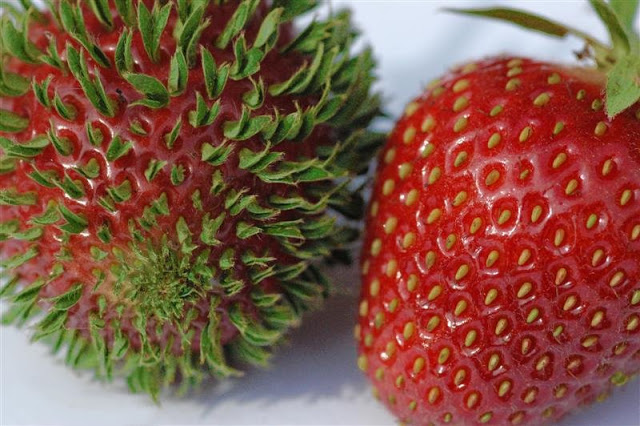
Bean Sprout
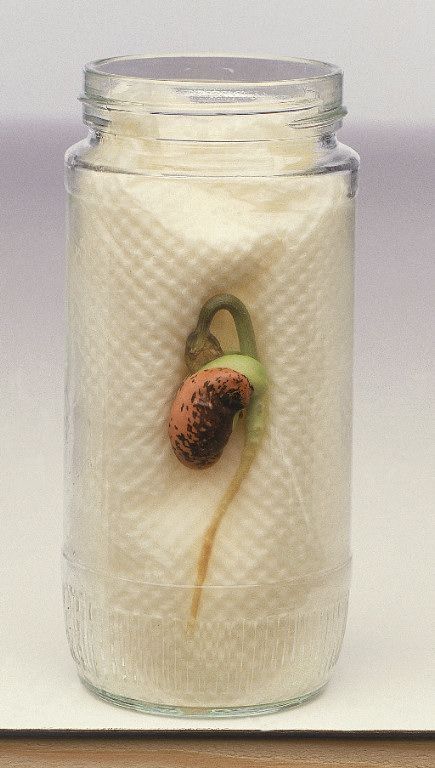
Indian Corn Sprouting

by Susan Dean | Feb 5, 2018 | Gardening, Plants, Seeds

Click on link for other pages:
Seeds Feed the World . . . from rice to corn to beans! Seeds look dead, but they are little packages of life. They may be small as a speck of dust or large as a football. There are small seeds that produce large plants and large seeds that produce small plants. The average size of a seed is about the size of a rice kernel.
Seeds come in many different kinds of seed packages. Some contain one seed and some contain thousands. Seeds may be covered by a husk (corn), skin (cherry), pod (pea), rind (lemon), peel (banana), shell (nut), or hull (grain). Seeds may also be inside a pit or stone such as in the peach or cherry.
Some seeds grow quickly and some grow very slowly. Some die if planted too deep. Some require a freeze and some constant warmth or great heat to sprout.
Seeds travel in ingenious ways. They travel as food, are carried by wind or ocean, shot out of a pod, buried by animals, or have barbs, hooks, or spines that stick to things. Some seeds have wings and hair.
For a seed to grow it needs the right amount of water, soil, and sun. Seeds have a tiny plant inside, the embryo, with one or two seed leaves (the cotyledons.) All seeds have an endosperm, food for the new plant until it is established.
Seeds with hard seed coats can be soaked overnight to soften them for sprouting Okra and moonflower are seeds I always soak. Seeds have seed coats and water causes the seed to swell inside creating pressure that cracks open the coat for the sprout to grow. First, a tiny root is sent down into the earth to drink water and get nutrients. Then a little stem reaches out for the sky and 2 small leaves (cotyledons) appear.
Mostly insects pollinate flowers and then fertilization occurs. A yellow pollen grain from the stamen of the flower lands on the pistil and grows a tube down to the ovary of the flower that holds the ovules or eggs. An ovule is fertilized and a seed is formed.
Some seeds stay dormant through the winter till spring comes. Scientists have been able to sprout seeds dormant for a very long time. You can also propagate new plants from older plant parts of stem, root or leaf cuttings and from layering (just put a little dirt and a rock on a limb of rosemary or thyme.)
Why did the seed shiver? Because it lost its coat.
Starting seeds indoors gives you earlier vegetables and flowers and cultivar choices are endless. Gather containers, soil mix, watering can, marking pen, and seeds. Soaking seeds with hard coats like peas or okra overnight before planting shortens sprouting time.
Choose containers with good drainage. Once seedlings form true leaves they need space for root growth. Peat pots, newspaper pots, cardboard tubes, or soil blocks go right into the soil.
Potting Mix – Combine equal parts compost and vermiculite.
Seed-Starting Mix
one part vermiculite or perlite
one part peat moss,
milled sphagnum moss
compost.
Moisten soil with warm water; fill containers and plant seeds! Space large seeds 1 inch apart, medium seeds ½ to 1 inch, and tiny seeds ½ inch. Sprinkle small seeds evenly: Take a pinch of seeds and slowly rotate to release the seeds or scatter fine seeds from a saltshaker.
Cover the seeds to a depth of three times their thickness by sprinkling with light dry soil and gently pat the surface. Label before mix-ups. Put the containers in a warm place and mist the soil until they sprout or set the pots in shallow containers of water. Once they develop true leaves, transplant.
Why did the seed shiver? Because it lost its coat.
From left to right: Black Oak, Valley Oak, Q. Oregon Oak, Coast Live Oak, Blue Oak, Tan Oak, Canyon Live Oak.

Our Dwindling Food Variety
As we’ve come to depend on a handful of commercial varieties of fruits and vegetables, thousands of heirloom varieties have disappeared. It’s hard to know exactly how many have been lost over the past century, but a study conducted in 1983 by the Rural Advancement Foundation International gave a clue to the scope of the problem. It compared USDA listings of seed varieties sold by commercial U.S. seed houses in 1903 with those in the U.S. National Seed Storage Laboratory in 1983. The survey, which included 66 crops, found that about 93 percent of the varieties had gone extinct.
by Susan Dean | Feb 5, 2018 | Gardening, Plants
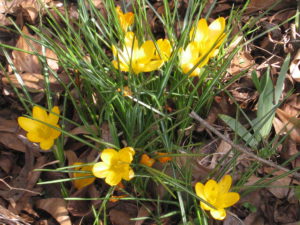
Crocus
To many gardeners, the autumnal rite of bulb planting is a ritual. Many spring bulbs naturalize well in most North American regions such as galanthus, scillas, crocuses, muscari, daffodils, and most species of tulips, alliums, and anemones.
When buying bulbs choose the largest ones, firm and solid, without nicks from shovels. If you can find daffs with two points – those may send up two flowering stalks. Buy organic. The flowers are brighter, stronger, and more fragrant.
Sloping garden areas, borders between shrubs, wooded spots, and even lawns are appropriate sites. Bulbs will rot in standing water so avoid areas that flood. Start with a dozen bulbs, choose your area and scatter them. Dig holes where they fall. If you want bulbs around a tree, dig a trench and scatter them in it. Don’t plant too thickly, but leave room for natural increases. Mulch lightly. Muscari, the grape hyacinth, looks better in front of daffodils than intermingled.
A six to seven pH is desirable for most bulbs; soil below 5.5 or above 7.3 will cause your bulbs to fail. If soil isn’t well drained or if it’s too hard, consider adding sand or soil rich in organic matter to lighten it.
Plant bulbs pointed-end up, three times as deep as their height from the base. Research found that planting tulips eight rather than six inches deep increases their life span significantly. Plant bulbs, in shade or full sun, before the first hard frost.
Rodents love crocuses, tulips, hyacinths, and blue grape muscari, but scillas, daffodils, and endymion they avoid. If plagued by animals eating the bulbs, try daffodils, alliums, chionodoxa, colchicum, fritillaria, galanthus, muscari, and scilla. The three most familiar bulb types—crocuses for early spring, then daffodils, and tulips assures the longest period of bloom.
A naturalized area gives an aura of carefree grace, an invitation to interact more fully with your garden than merely to observe its floral display. The hardy wood hyacinth or Spanish bluebells make a worthy tulip companion. Its high stalks are laden with bell-shaped blossoms in blue, pink, or white.
Deadhead tulips, daffodils and hyacinths to keep them from forming seed. The energy that goes into making seed will weaken the bulb. Don’t cut leaves until they brown. Bulbs are nourished by aging foliage.
It’s also a good time to plant garlic and onions and spinach, lettuce and kale. Spinach can overwinter in most years and give a healthier crop in spring.
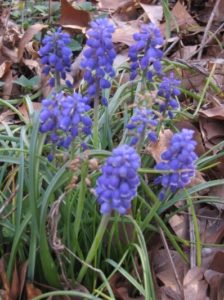
Grape Hyacinths, or Muscari, are bulbs that bloom early in spring. They are sometimes called “lent flowers” or “church steeples.” They are perennial with grapelike flower stalks of blue, purple, white, and yellow. The bulbs spread easily and tolerate very cold weather. They make stunning borders and are one of the plants to choose if deer are a problem. These easy-care bulbs are frequently mass-planted to create a river effect in borders. Leaves will emerge in late summer and persist through the winter, making a nice looking winter border along paths. They are one of the useful bee plants of spring. Perennials zones 4 through 8. To prevent grape hyacinths from self-sowing, remove spent blooms.

The snowdrop shares its symbolism with the carnation, as they are both the birth flower for the month of January.
As the snow in their name suggests, Snowdrops may not even wait for the snow to melt before emerging from their winter sleep and push right up through the snow. The white flowers are usually borne singly, mostly in early spring but sometimes in mid to late winter, which makes them the earliest flowering bulb. Bulbs prefer full sun and a rich well-draining soil. Avoid planting single bulbs, Small groups are best.
Galanthamine (a dream enhancing natural nutrient) is extracted. Other plants include the red spider lily (Lycoris radiata) and daffodil. Galanthamine is an approved natural herbal extract and a key ingredient in Brilliant Dreams.
by Susan Dean | Feb 5, 2018 | Gardening, Plants
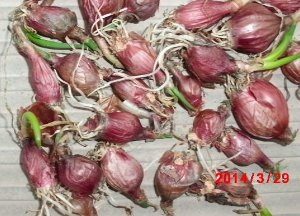
WHAT IS A BULB?
The word “bulb” is loosely used to describe plants growing from an underground mass of food storage tissues. Bulbs store enough food to enable the plants to grow and flower without added nutrients during the first year. The storage tissue is like the bulb’s lunch box, packed with enough food for the whole growing season!
A bulb is a modified stem containing a complete miniature plant, including embryonic leaf, stem, and flower parts, and surrounded by fleshy scales that provide food for the young plant and a basal plate that produces roots. A thin protective layer called a tunic surrounds the bulb.
Tulips, daffodils, and onions are true bulbs. If you slice a bulb in half horizontally, you’ll see rings formed by the scales, and if you look at one close to planting time, you’ll see a small plant in the center. An onion left in storage for too long makes a great example.
Some other plants we call bulbs, such as crocus, iris, and dahlias aren’t true bulbs because they have different botanical structures than those listed above. Crocus and gladiolus are corms. A corm stores most of its food in an enlarged basal plate rather than in its scales. Tubers, like dahlias and tuberous begonias, sprout new stems and roots from “eyes” on their surface. Rhizomes, such as iris, calla lilies, and cannas are horizontal stems capable of producing shoots and roots.
The distinction between these storage organs is very important and provides information for scientific classification and offers clues about the origin and evolution of plants. Most gardeners lump them all together as bulbs.
Bulbs are divided into two categories based on when they bloom. Spring-flowering bulbs, such as daffodils and tulips, are planted in the fall. They are called hardy bulbs because they survive cold winter conditions. They need exposure to cold temperatures in order to flower properly. Summer-flowering bulbs, including dahlias, begonias and gladiolus, are planted in the spring. They are tender and don’t survive cold winter conditions.
Spring-Flowering or Hardy Bulbs. Hardy bulbs need to be in the ground before it freezes. Bulbs develop their roots soon after planting, and lie dormant during most of the winter. When the weather warms, they draw on that “lunch box” of stored energy to produce leaves and stems, and then flowers. Some bulbs require fewer cold hours and less warming to bloom and their flowers emerge in early spring. Tulips need a longer cooling period and warmer temperatures to emerge.
Some regions are too warm to successfully grow hardy bulbs. Paper white narcissus is a good choice for warmer climates because most do not require a long cold treatment.
Bulbs take in nutrients and produce new food through photosynthesis. They store food not used for daily living in their storage organs for next year’s growth. It’s important not to cut back the leaves as soon as the bloom is spent. Once there’s enough energy in the “lunch box,” bulb leaves turn brown and die, and the bulb enters a dormant state through the summer, fall, and winter months.
Summer-Flowering or Tender Bulbs do not survive extremely cold winters and are planted after the last hard frost has passed. There are summer-flowering lilies that are hardy enough to survive winters in some areas. In northern climates, you must dig up tender bulbs and store them in a dark place that stays cool enough to keep them from sprouting prematurely.
When pollinated, most bulb flowers will produce seeds, and you can use them to grow new plants. It takes at least 5 years, and sometimes longer, for seedlings to mature and produce flowers. Many bulbs also reproduce via bulblets or offsets, tiny bulblets that form on the “mother” bulb. These baby bulbs grow over time, and once they have stored enough energy you can separate them from the mother bulb to grow new plants. These mature more quickly than seedlings. For rhizomes and tubers you propagate new plants by division.
Forcing bulbs is the process of exposing bulbs to necessary cold temperatures in a refrigerator and then planting them in an environment that makes them think it is time to grow.
by Susan Dean | Feb 5, 2018 | Plants
Branching Roots
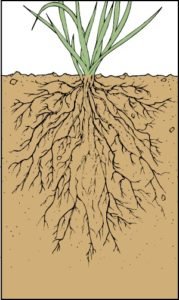
Prop Roots

TAP Root
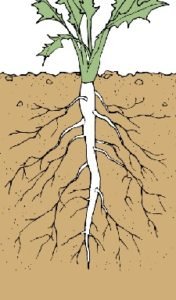
Aerial roots
 Roots are organs of attachment (anchoring the plant to the ground) and organs of absorption and transport for water and dissolved salts. The tip of the root, called the root cap forces its way into solid earth. For this purpose the root cap is made up of layers of flattened and hardened cells.
Roots are organs of attachment (anchoring the plant to the ground) and organs of absorption and transport for water and dissolved salts. The tip of the root, called the root cap forces its way into solid earth. For this purpose the root cap is made up of layers of flattened and hardened cells.
Behind the root cap is a thick white down consisting of thousands of tiny hairs. This part of the root has the function of absorbing water, with mineral salts dissolved in it, from the soil. Water is absorbed into the roots by a process called osmosis. The liquid inside the root hairs is a rather strong solution of sugars and mineral salts; the water in the soil is a weak solution of mineral salts. The outer skin of the root hairs is a semi permeable membrane, with the special property of enabling weaker solutions to pass through into stronger ones. As long as the solution inside the root hairs is stronger than that outside, they will take in water that is carried up to the aboveground parts of the plant through slender tubes of xylem and phloem.
Roots sometimes give out substances in solution. If the root meets a hard substance such as marble, which is insoluble in water, it gives out carbon dioxide. When mixed with water, this carbon dioxide acts on the calcium carbonate in the marble and turns it into soluble sodium bicarbonate that the root can then absorb.
Root growth
Normally, roots grow downward under the influence of gravity and away from light. This reaction enables a sprouting seed to get a hold in the soil.
There are two basic patterns of root growth:
The taproot system found, for example, in dandelions
The fibrous system found as in grasses. In fibrous systems the primary root is displaced by numerous fine roots from the base of the stem.
The taproot system is an extension of the primary root (radicle) of the young seedling.
All roots that do not grow from the primary root (ex. roots on a rhizome) are called adventitious. Propagation of plants by cuttings relies on the development of adventitious roots on the stem.
Root structure
At the tip of all roots is a mass of cells – the root cap – that protects the growing point during its passage through the soil. The actively dividing cells of the growing point produce the cells of the root cap. As the outer parts of the root cap wear away, fresh cells replace them. The old cap cells may also lubricate the tip, as it grows downward. Cells formed just behind the tip lengthen rapidly and push the tip further into the soil with considerable force.
The growing region is followed by the root hair region. The hairs are outgrowths of the epidermis and are the main organs of absorption. They penetrate the soil and absorb water and occupy only a limited region. Hairs in the growing region would be sheared off as the root pushed downward. Each hair has only a brief existence and as the hairs die off they are replaced with new ones further down.
The root contains the same sort of tissues as the stem but the strengthening tissues of the root are centrally placed, reflecting the pulling strain suffered by the root as opposed to the bending strain imposed on the stem.
Cross sections of the root hair region of a typical root are shown in the illustrations. The inner layer of the wide cortex is called the endodermis. The walls of this layer become thickened with a corky substance. Within the endodermis is the stele whose outer layer is of parenchyma cells and is called the pericycle. The protoxylem is on the outside of the xylem tissue that is star-shaped as a rule. Monocotyledons (grasses) usually have more “arms” than dicotyledons (buttercups). A central pith occurs in some species. Secondary growth usually occurs only in dicotyledons.
Branching in the root
In the stem, buds develop from the outer tissues close to the tip. Root branches develop behind the growing region and are endogenous (they develop internally). Branching develops before secondary thickening begins. Cells of the pericycle opposite the protoxylem groups become active and produce a growing point just like that of the main root. This new tip grows through the cortex just as the main root grows through the soil. When it breaks out of the parent root the vascular connections are complete and the region is behind that of the root hairs.
Between the root and the stem is a region called the hypocotyl. In this region the vascular tissues change from the root arrangement to that of the stem, but they are continuous all the way through.
Uses of Roots
Many plants are economically important root crops. Taproots, such as the beet, carrot, parsnip, radish, turnip, sweet potato, salsify, and cassava are used as food. Many fibrous and taproots are used for flavorings or in making medicines. Goldenseal, jalap, licorice, and mandrake roots are used in flavoring medicines. Common food flavorings are obtained from the roots of such plants as ginger, horseradish, angelica, and sarsaparilla. Some of the roots used in making drugs are colchicum and ipecac. Fibrous root systems are also agriculturally important because they hold topsoil in place and prevent soil erosion
Roots growing aboveground from parts of the plant other than the stem base are called adventitious roots. There are two kinds of adventitious roots: prop roots and aerial roots. Prop roots, and many aerial roots, penetrate the soil. For example, prop roots of corn grow from upper parts of the stem down to the soil, and the aerial roots of poison ivy grow from horizontal branches down to the soil. Some aerial roots do not penetrate the soil, but become attached to other plants or objects instead. Plants with such roots are called epiphytes. Many orchids are epiphytes.
Root modifications
Very often the root is modified for storage. Roots which survive the winter contain food material which will be used by the developing shoots in spring. The climbing roots of ivy are adventitious – arising all the way along the stem – and the roots on strawberry runners. Some tropical orchids that grow on tree-trunks have spongy roots exposed to the air. The roots absorb moisture and may contain chlorophyll too.
Maize plants and many others have stilt roots that develop from nodes on the stem and provide extra support. The banyan tree uses prop roots. Roots develop in the horizontal branches and grow into the soil. They form solid supports for the spreading branches.
Some swamp-growing plants such as mangroves develop breathing-roots. The swampy soil is poor in oxygen and some root branches, which may or may not be adventitious, grow upwards into the air. Oxygen diffuses into these and into the rest of the root system.
The term “bulb” is used by most people to refer to plants with underground fleshy storage structures. Only some of the plants commonly called bulbs actually are bulbs. The definition of a bulb is any plant that stores its complete life cycle in an underground storage structure. The primary function of these underground storage structures is to store nutrient reserves to ensure the plants’ survival. Bulbs or bulb-like plants are usually perennials. They have a period of growth and flowering followed by a period of dormancy. They die back to ground level at the end of each growing season. For spring bulbs, the end of the growing season is in late spring or early summer. Spring bulbs start to grow again in the fall and flower the following growing season.
Bulbs can be broken down into five types of storage structures: true bulbs, corms, tubers, tuberous roots and rhizomes. A sixth category of fleshy roots has been added for the purpose of showing the structure.
True Bulbs
The true bulb has five major parts. It contains the basal plate (bottom of bulb from which roots grow), fleshy scales (primary storage tissue),tunic (skin-like covering that protects the fleshy scales), the shoot(consisting of developing flower and leaf buds), and lateral buds (develop into bulblets or offsets).
True bulbs are divided into tunicate bulbs and imbricate bulbs. A tunicate bulb has a paper-like covering or tunic that protects the scales from drying and from mechanical injury. Examples of tunicate bulbs are: tulips, daffodils, hyacinths, grape hyacinths, and alliums. Many plants such as daffodils form new bulbs around the original bulb. These bulbs, called offsets, develop from buds within the base of the mother bulb and produce new plants. When bulbs become too crowded, the flowers start to diminish in size. It is time to dig up and divide the bulbs.
An example of the imbricate bulb is the lily. The imbricate bulb does not have the tunic (papery covering) to protect the fleshy scales. Imbricate bulbs must be kept constantly moist before planting so they aren’t injured by their scales drying out.
Lilies can be propagated from bulbils that develop in the leaf axils of the plant and from bulblets that develop at the base of fleshy lily scales if maintained in a moist sand medium. It will take more than one year for the bulbils or bulblets to flower.
Corms
A corm is a swollen stem base that is modified into a mass of storage tissue. A corm does not have visible storage rings when cut in half. This distinguishes it from a true bulb. The corm contains a basal plate (bottom of bulb from which roots develop), a thin tunic and a growing point. Examples of plants that develop from corms are gladiolus and crocus. When gladiolus corms are dug in the fall, they should be separated into well-developed corms and stored for replanting. Newly dug corms will have cormels that are pea size around the top of the old corm. The old corm will be directly beneath the newly formed corms. When the corm is cleaned up and the old stem removed, the growing point of the corm will be evident. The cormels can be saved and replanted in the back of the garden. Examples of plants that develop from corms are gladiolas and crocus.
Tubers
A tuber differs from the true bulb and the corm by not having a basal plant from which roots develop and not having a protective tunic covering. The caladium tuber has buds scattered over the tuber surface from which shoots and roots develop. Examples of plants that develop from tubers include caladiums, oxalis and anemones, and the common vegetable, the potato.
Tuberous Roots
The tuberous root differs from other root structures by the nutrient reserves being stored in an actual root instead of an enlarged stem. The dahlia reproduces from buds at the top end of the root or base of the stem. The tuberous root of a dahlia should not be divided before placing in storage in the fall but should be divided at planting time. The root should be divided into sections with an eye-bearing portion of the stem left with each section of the root. The tuberous-rooted begonia reproduces from buds on top of the round, flat tuber.
Rhizomes
Rhizomes differ from other storage structures by growing horizontally just under the surface of the soil. On some plants, this type of rooting structure can be very invasive. The lily-of-the-valley rhizome spreads horizontally underground and produces pips that develop into new plants. This plant is increased in the landscape by digging in the fall and removing pips with developed roots for replanting.
Fleshy Roots
Plants that have fleshy roots store nutrient reserves in the fleshy roots. Peonies and daylilies can be propagated by dividing them. The root clumps of peonies should be divided in the fall leaving at least three crown buds with each clump. The daylily can be divided in the fall or spring into plantlets with a single fan of leaves. The daylily has a fleshy root system with some varieties having what might be considered a rhizome type root system.
The birch tree produces a “plate” root that only takes hold of the soil superficially. It will grow in poor soils but depletes them even further.
The oak tap root is said to go down as deep as its crown extends up into the sky. In spite of this, it does not exhaust the soil but rather tends to improve it.
Roots of the Oak Tree

Roots of the Birch
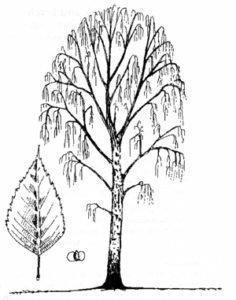

by Susan Dean | Feb 5, 2018 | Plants, Self Science
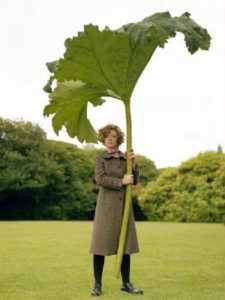 Gunnera Tinctora leaf
Gunnera Tinctora leaf
ROOTS AND LEAVES
Roots and leaves are the parts of the plant that are most important to feeding the plant. Review the song about the 6 plant parts. Where do plants get food to grow? You don’t see them in the grocery store! The leaves are like little food factories that synthesize the light of the sun into the sugar glucose. It is a process called photosynthesis. The leaf also transpires water through its leaves and breathes air through little structures on the underside of the leaf called stoma. They look like 2 lips and they open and close. Show pictures of stoma. Plants take in the carbon dioxide and put oxygen back in the air through their leaves.
The roots of a plant are important to anchor the plant and drink in water and nutrients from the soil. There are 4 basic root types: branching, tap roots, bulbs and tuber. Show kids samples of each type root and see if they can name which one it is when you hold it up.Pass out different kinds of leaves to each table for kids to examine and have them do some leaf rubbings. Point out the veins that run through the leaves that carry water and nutrients from the soil.
MATERIALS: Hand drum, chart of photosynthesis, samples of leaves, samples of root systems, picture of stoma in leaves, paper and crayons for rubbings
Activities: Sing plant songs and add ” My Roots Go Down”, leaf rubbings, grow sweet potatoe from a tuber. Let them go out with you to dig a few plants to examine their roots . . . maybe wild onion bulb, or grass, dandelion or a baby oak’s tap root. Note the arrangement of the leaves. Pick different leaves in the garden and have kids go on a leaf hunt to discover the plant in the garden that has their leaf. Grow a little duckweed in a glass of water and let them see the roots and watch them grow. Bring some root for a snack . . . maybe carrots! or radish or a little onion. Put a white carnation or queen Anne’s lace in a glass of water with a few drops of food coloring and let them observe the roots drinking up the color.
Some leaves may exibit guttation – when the leaves exude droplets of sap.
Guttation

Leaf Veins
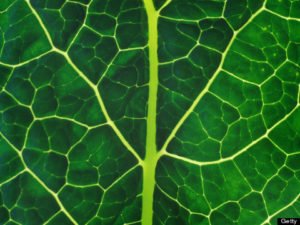
Lacinato kale














 Roots are organs of attachment (anchoring the plant to the ground) and organs of absorption and transport for water and dissolved salts. The tip of the root, called the root cap forces its way into solid earth. For this purpose the root cap is made up of layers of flattened and hardened cells.
Roots are organs of attachment (anchoring the plant to the ground) and organs of absorption and transport for water and dissolved salts. The tip of the root, called the root cap forces its way into solid earth. For this purpose the root cap is made up of layers of flattened and hardened cells.


 Gunnera Tinctora leaf
Gunnera Tinctora leaf
